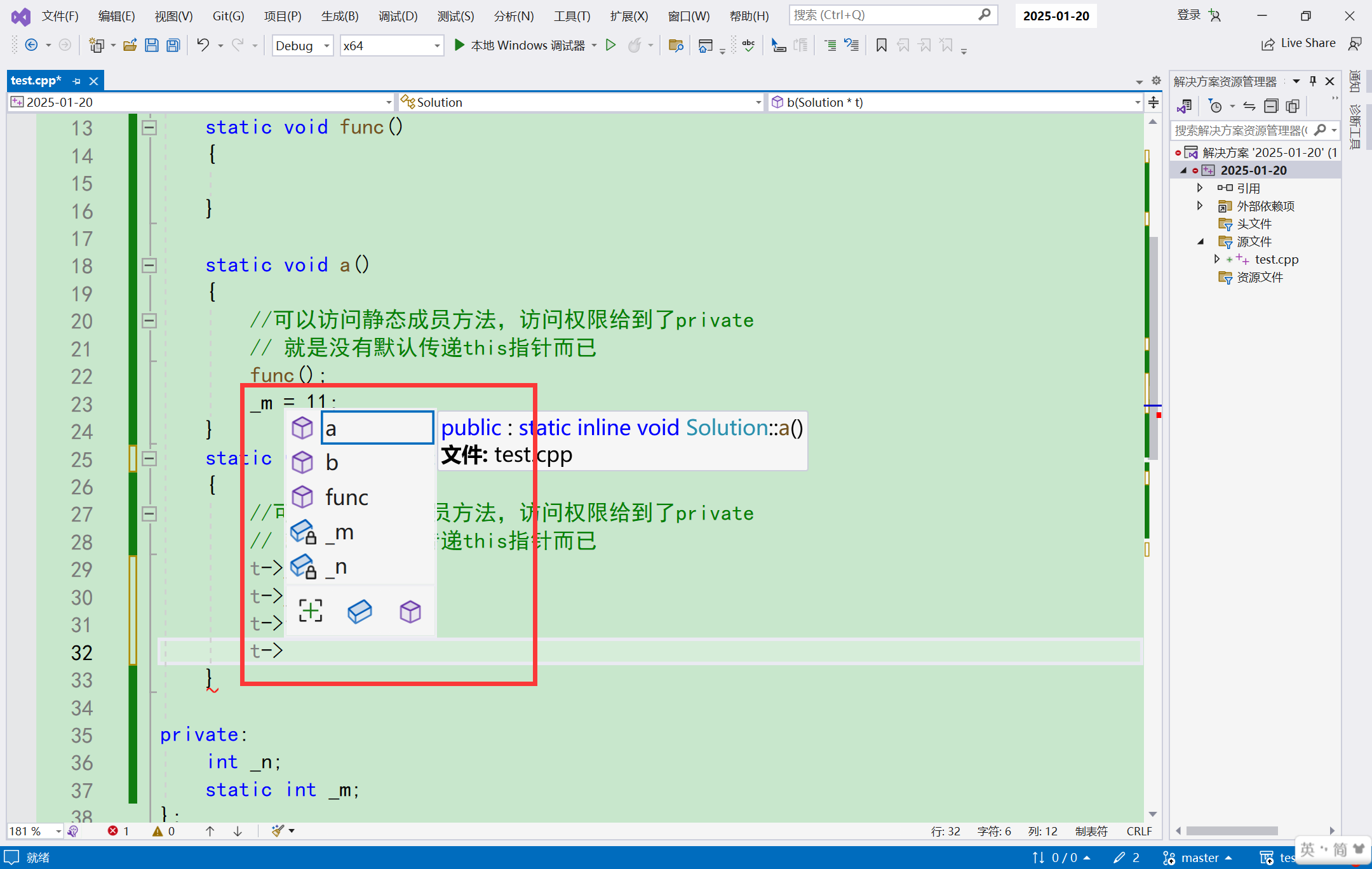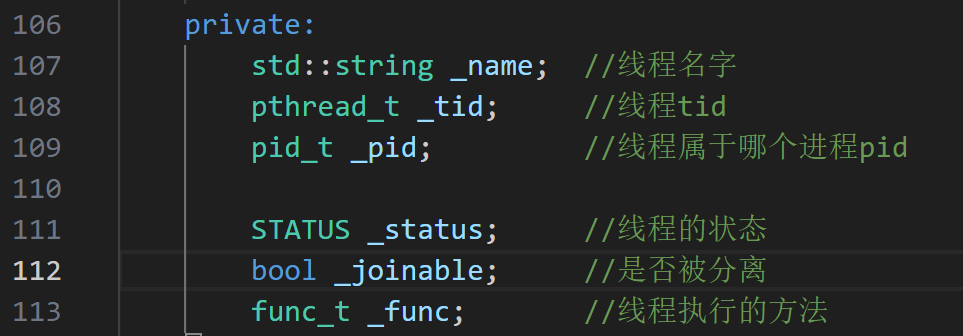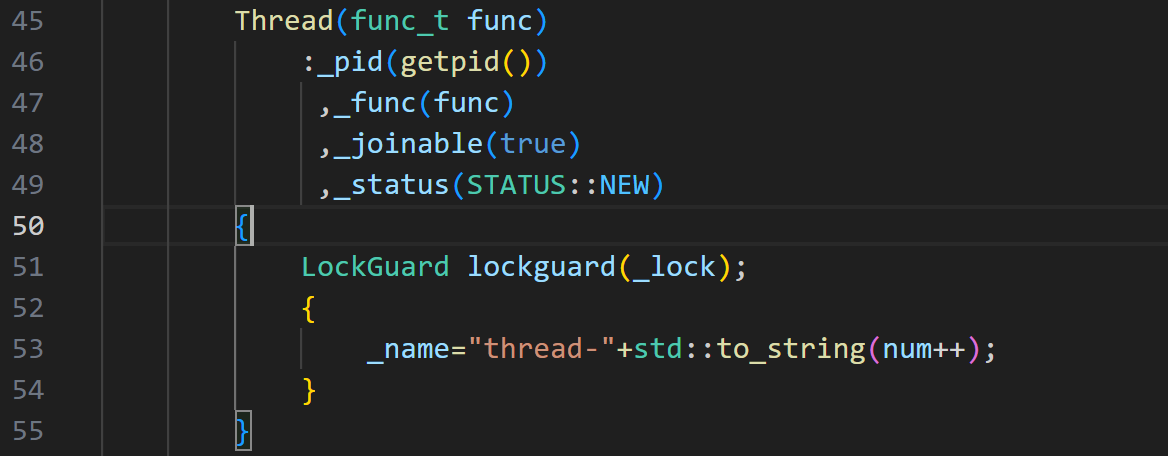【Linux课程学习】:锁封装(Mutex)线程封装(Thread),this指针_线程锁封装
🎁个人主页:我们的五年
🔍系列专栏:Linux课程学习
🌷追光的人,终会万丈光芒
🎉欢迎大家点赞👍评论📝收藏⭐文章


Linux学习笔记:
https://blog.csdn.net/djdjiejsn/category_12669243.html
前言:
C++中已经封装了线程,在这里我们自己对线程进行封装,能更好的理解C++中的线程封装。我们自己封装的线程肯定比不了C++线程库中的封装,但是也能锻炼我们。
目录
下面关于锁的封装看看下面的:
1.访问内部私有成员变量
2.Thread成员变量:
2.1.首先肯定是线程的tid:pthread_t _tid。
2.2.进程的pid:pid_t _pid;。
2.3.线程的状态:
2.4.是否被分离:
2.5.线程名字
2.6.执行的方法:
3.内部成员方法:
3.1构造函数:
3.2Start函数:
3.3Stop函数:
4.整体代码:
下面关于锁的封装看看下面的:
Lockguard的构造函数加锁,析构函数解锁,用起来很方便。
namespace MutexModule{ class Mutex { private: Mutex(const Mutex &) = delete; const Mutex &operator=(const Mutex &) = delete; public: Mutex() { int n = ::pthread_mutex_init(&_mutex, nullptr); (void)n; } void Lock() { int n = ::pthread_mutex_lock(&_mutex); (void)n; } void UnLock() { int n = ::pthread_mutex_unlock(&_mutex); (void)n; } pthread_mutex_t *LockPtr() { return &_mutex; } ~Mutex() { int n = ::pthread_mutex_destroy(&_mutex); (void)n; } private: pthread_mutex_t _mutex; }; class LockGuard { public: LockGuard(Mutex &mtx) : _mtx(mtx) { _mtx.Lock(); } ~LockGuard() { _mtx.UnLock(); } private: Mutex &_mtx; };}1.访问内部私有成员变量
1.类中的static函数为什么不能直接访问内部成员变量?
因为默认没有传this指针。所以static函数参数中有this指针的时候,还是可以访问的,此时this(对象)指针不能省略。
2.外部函数不能访问私有成员?
没有默认传递this指针,没有访问权限。声明是类的友元函数的时候,也是可以访问的。
代码:
#include using namespace std;class Solution {public:Solution():_n(1111){}friend static void test(Solution* t);static void func(){}static void a(){//可以访问静态成员方法,访问权限给到了private// 就是没有默认传递this指针而已func();_m = 11;}static void b(Solution* t){//可以访问静态成员方法,访问权限给到了private// 就是没有默认传递this指针而已t->_n = 555;t->_m;t->func();}private:int _n;static int _m;};void test(Solution* t){//能访问是传递了Solution对象,是Solution类的友元//friend static void test(Solution*& t);t->_n = 222;}
2.Thread成员变量:
2.1.首先肯定是线程的tid:pthread_t _tid。
2.2.进程的pid:pid_t _pid;。
pthread_t _tid;
pid_t _pid;
2.3.线程的状态:
enum class STATUS
{
RUNNING=1,
STOP,
NEW //新的线程的状态
};
STATUS _status;
表示线程的状态,NEW表示新的线程,还没有进行Start操作时的状态信息。
2.4.是否被分离:
线程默认是没有被分离的,而且只有分离和没有被分离两种情况,bool类型。
bool _joinable; //是否被分离
join命名就是,当joinable为true的时候,主线程要进行join,为false的时候,就不要进行join。
void EnableDetach(){ //状态变为false,新的线程默认为true _joinable=false;}void Detach(){ EnableDetach(); //线程分离 pthread_detach(_tid);}2.5.线程名字
为了区分不同的线程可以给线程取个名字。
std::string _name;
名字可以取\"thread-num\"表示是第几个线程。
2.6.执行的方法:
这里定义的是void(std::string name),返回值为void,参数是string的函数。
using func_t=std::function(void(std::string name));

3.内部成员方法:
3.1构造函数:
_name:
线程名字以\"thread-num\"来命名,表示第几个线程。所以定义一个static int num进行记录有多少个线程。但是这是临界资源,线程再创建线程,导致方式混乱。
static int num=1;
_joinable:
_joinable默认是没有被分离的,所以是true。
_func:
_func是外部传进来要执行的方法。所以要有func_t 参数。
_status:
为新线程,状态为NEW。
_tid:
在线程创建的时候,传到pthread里面进行确定。
Thread(func_t func) :_pid(getpid()) ,_func(func) ,_joinable(true) ,_status(STATUS::NEW){ LockGuard lockguard(_lock); { _name=\"thread-\"+std::to_string(num++); }}
3.2Start函数:
先判断是不是没有在RUNNING,如果在RUNNING就返回false。然后创建线程进行执行,状态修改。
static void* Routine(void* args){ Thread* t=static_cast(args); t->_status=STATUS::RUNNING; t->_func(t->Name()); return nullptr;}bool Start(){ if(_status!=STATUS::RUNNING) { int n=::pthread_create(&_tid,nullptr,Routine,this); if(n!=0) { //线程创建失败 return false; } return true; } //已经在RUNNING了 return false;}3.3Stop函数:
bool Stop(){ //在运行的时候,才能cancle if(_status==STATUS::RUNNING) { _status=STATUS::STOP; int n=::pthread_cancel(_tid); if(n!=0) { return true; } } return true;}3.4Join函数,EnableJoin函数:
void EnableDetach(){//状态变为false_joinable = false;}bool Join(){//没有被分离才能joinif (_joinable){int n = ::pthread_join(_tid, nullptr);if (n != 0)return false;_status = STATUS::STOP;return true;}return false;}void Detach(){EnableDetach();//线程分离pthread_detach(_tid);}4.整体代码:
#pragma once #include #include #include #include #include #include #include #include #include \"Mutex.hpp\"namespace ThreadModule{ using namespace MutexModule; using func_t=std::function; static int num=1; enum class STATUS { RUNNING=1, STOP, NEW //新的线程的状态 }; class Thread { private: //执行方法,routine惯例 static void* Routine(void* args) { Thread* t=static_cast(args); t->_status=STATUS::RUNNING; t->_func(t->Name()); return nullptr; } void EnableDetach() { //状态变为false _joinable=false; } public: Thread(func_t func) :_pid(getpid()) ,_func(func) ,_joinable(true) ,_status(STATUS::NEW) { LockGuard lockguard(_lock); { _name=\"thread-\"+std::to_string(num++); } } bool Start() { if(_status!=STATUS::RUNNING) { int n=::pthread_create(&_tid,nullptr,Routine,this); if(n!=0) { //线程创建失败 return false; } return true; } //已经在RUNNING了 return false; } bool Stop() { //在运行的时候,才能cancle if(_status==STATUS::RUNNING) { _status=STATUS::STOP; int n=::pthread_cancel(_tid); if(n!=0) { return false; } return true; } return true; } bool Join() { //没有被分离才能join if(_joinable) { int n=::pthread_join(_tid,nullptr); if(n!=0) return false; _status=STATUS::STOP; return true; } return false; } void Detach() { EnableDetach(); //线程分离 pthread_detach(_tid); } std::string Name() {return _name;} bool JoinAble(){return _joinable;} ~Thread() { } private: std::string _name; //线程名字 pthread_t _tid; //线程tid pid_t _pid; //线程属于哪个进程pid STATUS _status; //线程的状态 bool _joinable; //是否被分离 func_t _func; //线程执行的方法 Mutex _lock; //锁进行保护 };}感谢阅读,相信美好的事情即将发生。


